Research Critique: Hand Hygiene and Infection Prevention Behaviours
VerifiedAdded on 2023/06/04
|14
|3434
|188
AI Summary
This research critique analyzes two studies on hand hygiene and infection prevention behaviours among medical and nursing students. The studies use cross-sectional self-reported observation and qualitative interpretive methods to explore the rationalization of behaviour and compliance with policy requirements. The findings offer directions for new research and recommendations for improving college education for nursing and medical students.
Contribute Materials
Your contribution can guide someone’s learning journey. Share your
documents today.
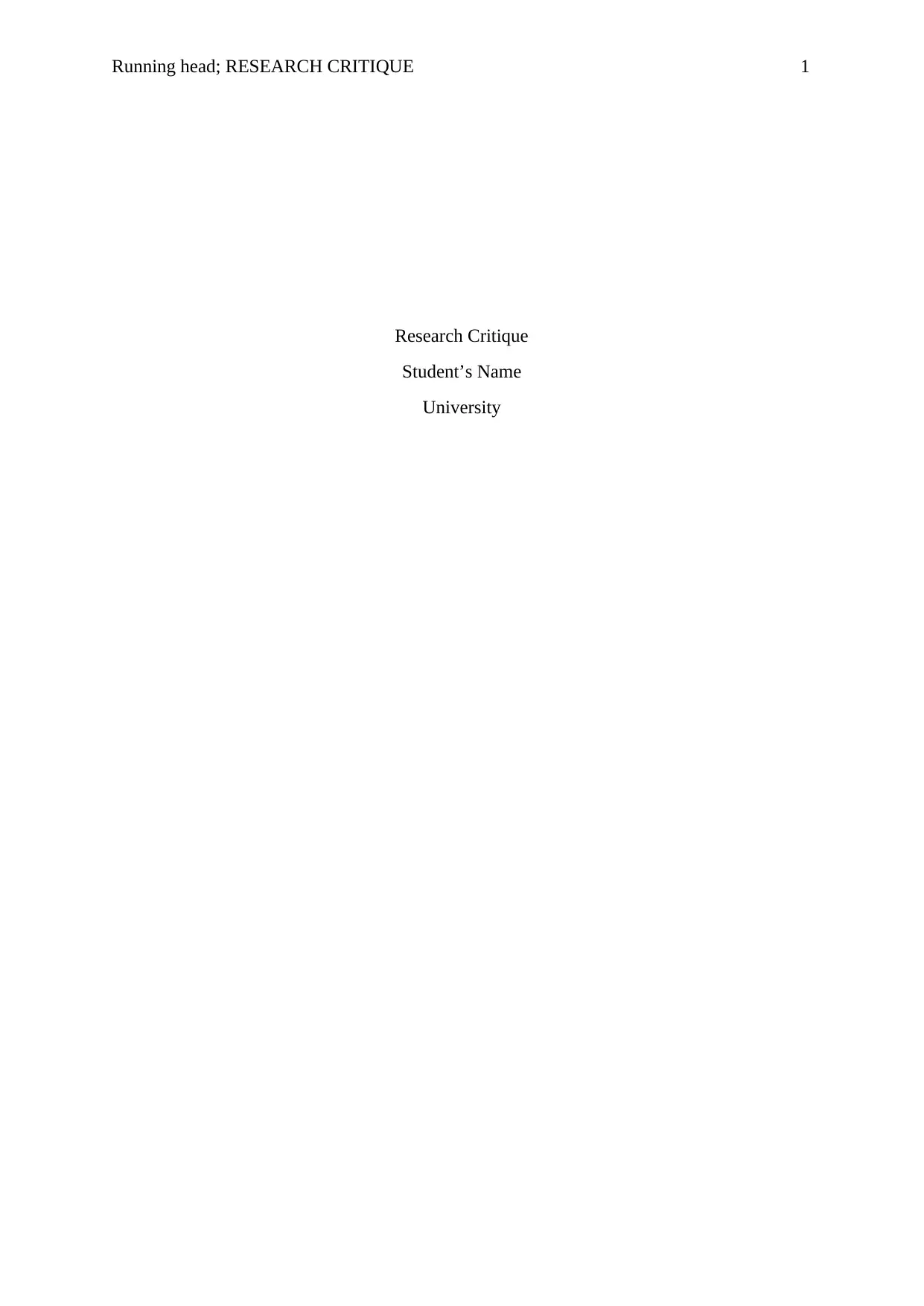
Running head; RESEARCH CRITIQUE 1
Research Critique
Student’s Name
University
Research Critique
Student’s Name
University
Secure Best Marks with AI Grader
Need help grading? Try our AI Grader for instant feedback on your assignments.
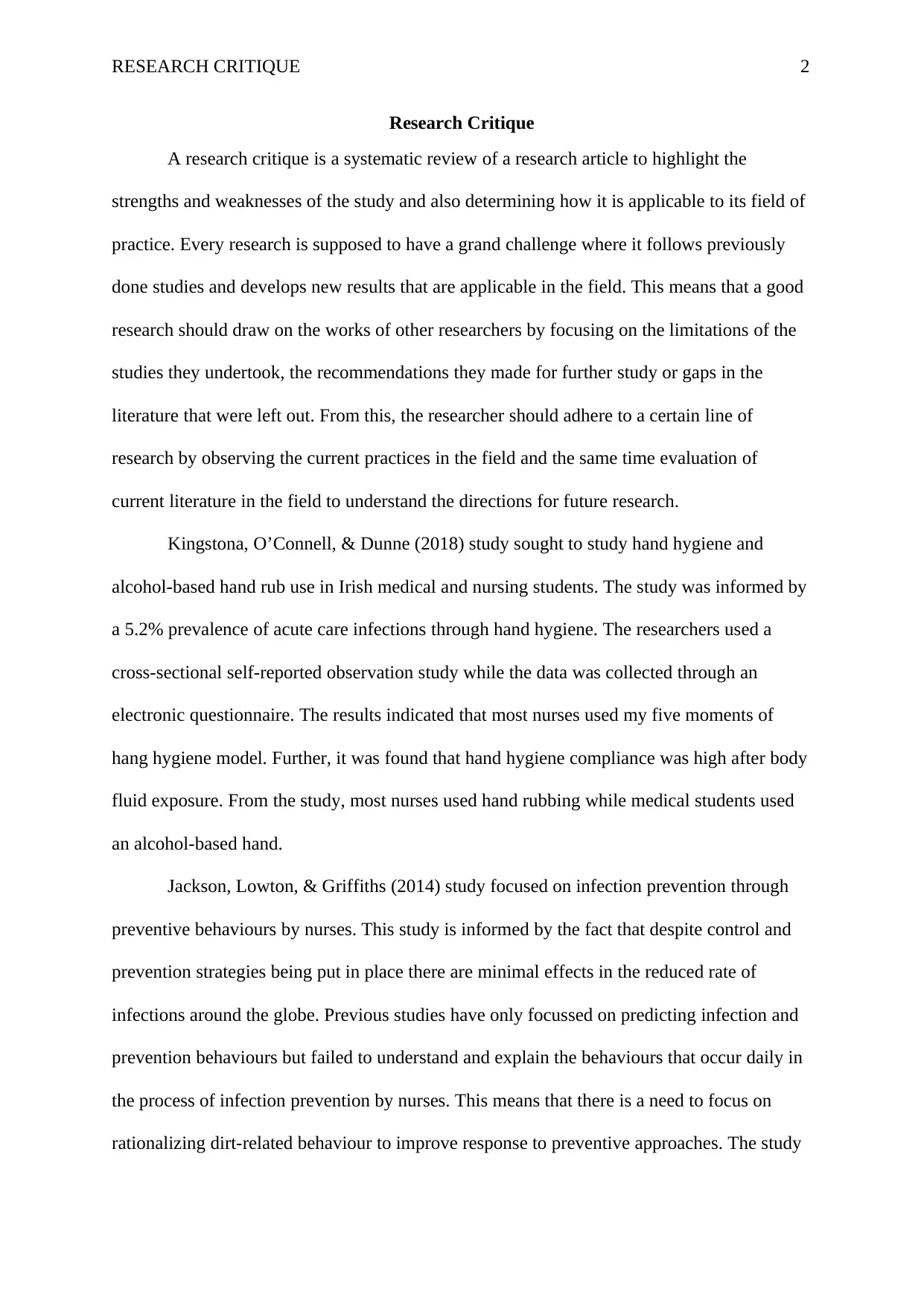
RESEARCH CRITIQUE 2
Research Critique
A research critique is a systematic review of a research article to highlight the
strengths and weaknesses of the study and also determining how it is applicable to its field of
practice. Every research is supposed to have a grand challenge where it follows previously
done studies and develops new results that are applicable in the field. This means that a good
research should draw on the works of other researchers by focusing on the limitations of the
studies they undertook, the recommendations they made for further study or gaps in the
literature that were left out. From this, the researcher should adhere to a certain line of
research by observing the current practices in the field and the same time evaluation of
current literature in the field to understand the directions for future research.
Kingstona, O’Connell, & Dunne (2018) study sought to study hand hygiene and
alcohol-based hand rub use in Irish medical and nursing students. The study was informed by
a 5.2% prevalence of acute care infections through hand hygiene. The researchers used a
cross-sectional self-reported observation study while the data was collected through an
electronic questionnaire. The results indicated that most nurses used my five moments of
hang hygiene model. Further, it was found that hand hygiene compliance was high after body
fluid exposure. From the study, most nurses used hand rubbing while medical students used
an alcohol-based hand.
Jackson, Lowton, & Griffiths (2014) study focused on infection prevention through
preventive behaviours by nurses. This study is informed by the fact that despite control and
prevention strategies being put in place there are minimal effects in the reduced rate of
infections around the globe. Previous studies have only focussed on predicting infection and
prevention behaviours but failed to understand and explain the behaviours that occur daily in
the process of infection prevention by nurses. This means that there is a need to focus on
rationalizing dirt-related behaviour to improve response to preventive approaches. The study
Research Critique
A research critique is a systematic review of a research article to highlight the
strengths and weaknesses of the study and also determining how it is applicable to its field of
practice. Every research is supposed to have a grand challenge where it follows previously
done studies and develops new results that are applicable in the field. This means that a good
research should draw on the works of other researchers by focusing on the limitations of the
studies they undertook, the recommendations they made for further study or gaps in the
literature that were left out. From this, the researcher should adhere to a certain line of
research by observing the current practices in the field and the same time evaluation of
current literature in the field to understand the directions for future research.
Kingstona, O’Connell, & Dunne (2018) study sought to study hand hygiene and
alcohol-based hand rub use in Irish medical and nursing students. The study was informed by
a 5.2% prevalence of acute care infections through hand hygiene. The researchers used a
cross-sectional self-reported observation study while the data was collected through an
electronic questionnaire. The results indicated that most nurses used my five moments of
hang hygiene model. Further, it was found that hand hygiene compliance was high after body
fluid exposure. From the study, most nurses used hand rubbing while medical students used
an alcohol-based hand.
Jackson, Lowton, & Griffiths (2014) study focused on infection prevention through
preventive behaviours by nurses. This study is informed by the fact that despite control and
prevention strategies being put in place there are minimal effects in the reduced rate of
infections around the globe. Previous studies have only focussed on predicting infection and
prevention behaviours but failed to understand and explain the behaviours that occur daily in
the process of infection prevention by nurses. This means that there is a need to focus on
rationalizing dirt-related behaviour to improve response to preventive approaches. The study
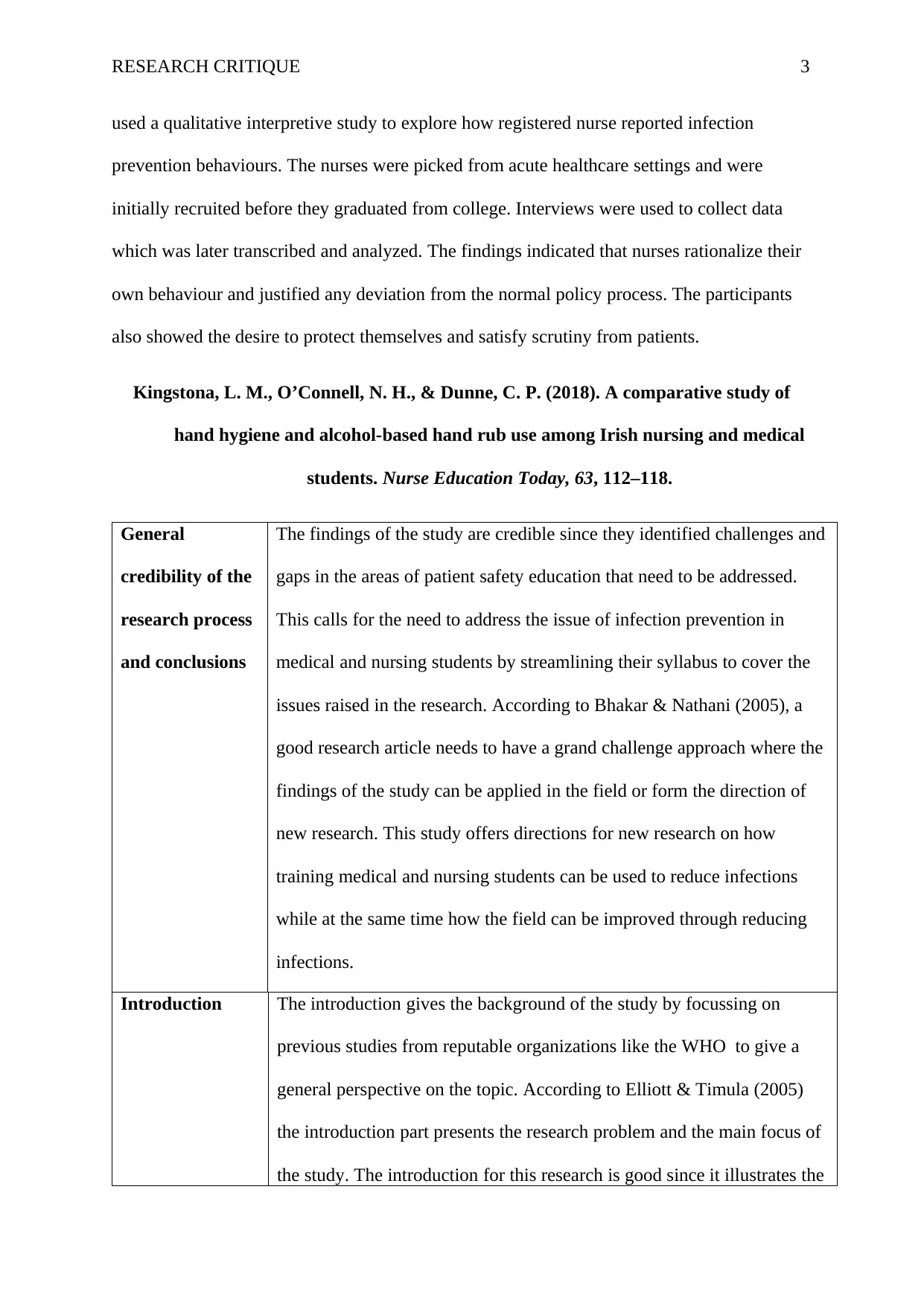
RESEARCH CRITIQUE 3
used a qualitative interpretive study to explore how registered nurse reported infection
prevention behaviours. The nurses were picked from acute healthcare settings and were
initially recruited before they graduated from college. Interviews were used to collect data
which was later transcribed and analyzed. The findings indicated that nurses rationalize their
own behaviour and justified any deviation from the normal policy process. The participants
also showed the desire to protect themselves and satisfy scrutiny from patients.
Kingstona, L. M., O’Connell, N. H., & Dunne, C. P. (2018). A comparative study of
hand hygiene and alcohol-based hand rub use among Irish nursing and medical
students. Nurse Education Today, 63, 112–118.
General
credibility of the
research process
and conclusions
The findings of the study are credible since they identified challenges and
gaps in the areas of patient safety education that need to be addressed.
This calls for the need to address the issue of infection prevention in
medical and nursing students by streamlining their syllabus to cover the
issues raised in the research. According to Bhakar & Nathani (2005), a
good research article needs to have a grand challenge approach where the
findings of the study can be applied in the field or form the direction of
new research. This study offers directions for new research on how
training medical and nursing students can be used to reduce infections
while at the same time how the field can be improved through reducing
infections.
Introduction The introduction gives the background of the study by focussing on
previous studies from reputable organizations like the WHO to give a
general perspective on the topic. According to Elliott & Timula (2005)
the introduction part presents the research problem and the main focus of
the study. The introduction for this research is good since it illustrates the
used a qualitative interpretive study to explore how registered nurse reported infection
prevention behaviours. The nurses were picked from acute healthcare settings and were
initially recruited before they graduated from college. Interviews were used to collect data
which was later transcribed and analyzed. The findings indicated that nurses rationalize their
own behaviour and justified any deviation from the normal policy process. The participants
also showed the desire to protect themselves and satisfy scrutiny from patients.
Kingstona, L. M., O’Connell, N. H., & Dunne, C. P. (2018). A comparative study of
hand hygiene and alcohol-based hand rub use among Irish nursing and medical
students. Nurse Education Today, 63, 112–118.
General
credibility of the
research process
and conclusions
The findings of the study are credible since they identified challenges and
gaps in the areas of patient safety education that need to be addressed.
This calls for the need to address the issue of infection prevention in
medical and nursing students by streamlining their syllabus to cover the
issues raised in the research. According to Bhakar & Nathani (2005), a
good research article needs to have a grand challenge approach where the
findings of the study can be applied in the field or form the direction of
new research. This study offers directions for new research on how
training medical and nursing students can be used to reduce infections
while at the same time how the field can be improved through reducing
infections.
Introduction The introduction gives the background of the study by focussing on
previous studies from reputable organizations like the WHO to give a
general perspective on the topic. According to Elliott & Timula (2005)
the introduction part presents the research problem and the main focus of
the study. The introduction for this research is good since it illustrates the
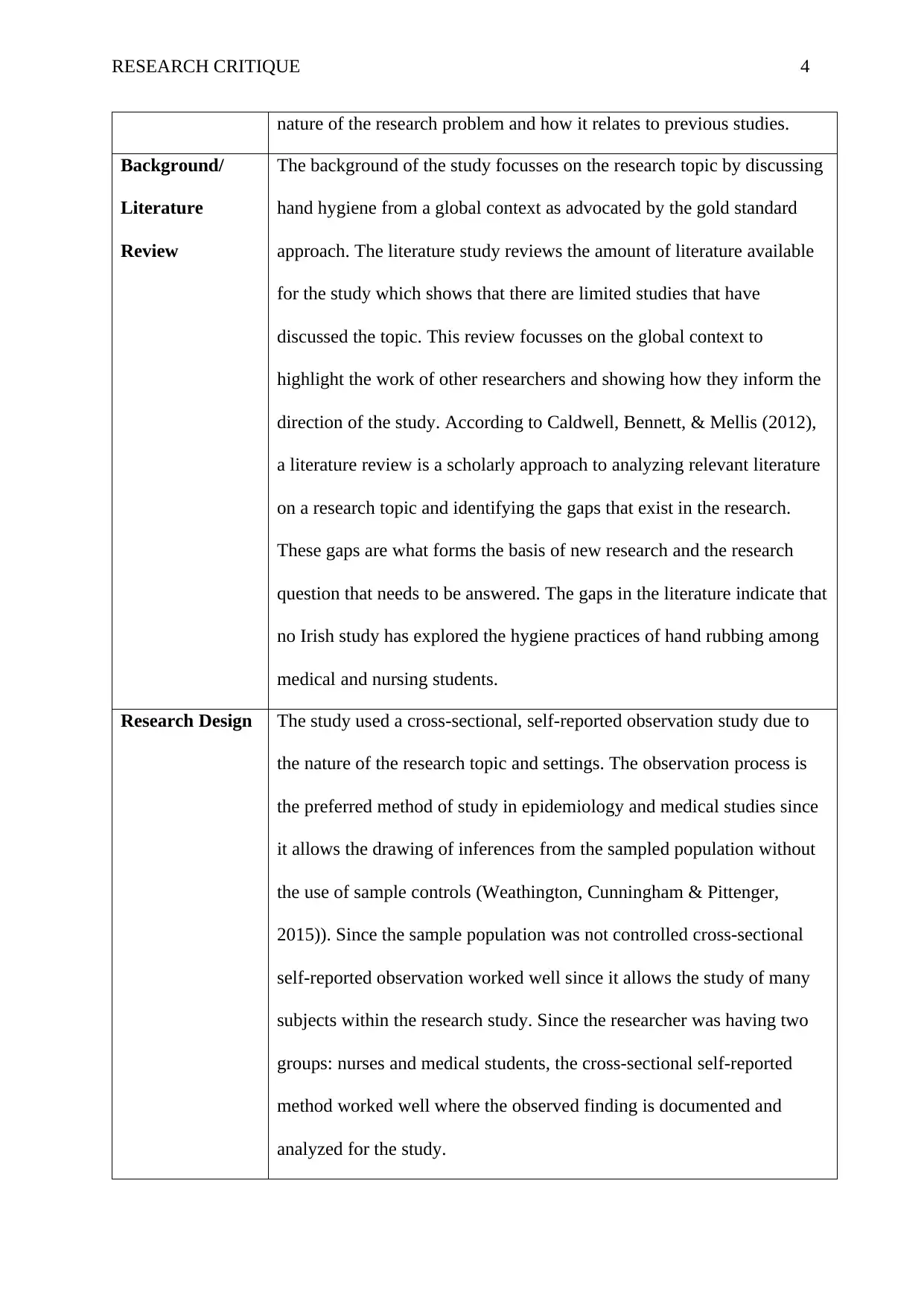
RESEARCH CRITIQUE 4
nature of the research problem and how it relates to previous studies.
Background/
Literature
Review
The background of the study focusses on the research topic by discussing
hand hygiene from a global context as advocated by the gold standard
approach. The literature study reviews the amount of literature available
for the study which shows that there are limited studies that have
discussed the topic. This review focusses on the global context to
highlight the work of other researchers and showing how they inform the
direction of the study. According to Caldwell, Bennett, & Mellis (2012),
a literature review is a scholarly approach to analyzing relevant literature
on a research topic and identifying the gaps that exist in the research.
These gaps are what forms the basis of new research and the research
question that needs to be answered. The gaps in the literature indicate that
no Irish study has explored the hygiene practices of hand rubbing among
medical and nursing students.
Research Design The study used a cross-sectional, self-reported observation study due to
the nature of the research topic and settings. The observation process is
the preferred method of study in epidemiology and medical studies since
it allows the drawing of inferences from the sampled population without
the use of sample controls (Weathington, Cunningham & Pittenger,
2015)). Since the sample population was not controlled cross-sectional
self-reported observation worked well since it allows the study of many
subjects within the research study. Since the researcher was having two
groups: nurses and medical students, the cross-sectional self-reported
method worked well where the observed finding is documented and
analyzed for the study.
nature of the research problem and how it relates to previous studies.
Background/
Literature
Review
The background of the study focusses on the research topic by discussing
hand hygiene from a global context as advocated by the gold standard
approach. The literature study reviews the amount of literature available
for the study which shows that there are limited studies that have
discussed the topic. This review focusses on the global context to
highlight the work of other researchers and showing how they inform the
direction of the study. According to Caldwell, Bennett, & Mellis (2012),
a literature review is a scholarly approach to analyzing relevant literature
on a research topic and identifying the gaps that exist in the research.
These gaps are what forms the basis of new research and the research
question that needs to be answered. The gaps in the literature indicate that
no Irish study has explored the hygiene practices of hand rubbing among
medical and nursing students.
Research Design The study used a cross-sectional, self-reported observation study due to
the nature of the research topic and settings. The observation process is
the preferred method of study in epidemiology and medical studies since
it allows the drawing of inferences from the sampled population without
the use of sample controls (Weathington, Cunningham & Pittenger,
2015)). Since the sample population was not controlled cross-sectional
self-reported observation worked well since it allows the study of many
subjects within the research study. Since the researcher was having two
groups: nurses and medical students, the cross-sectional self-reported
method worked well where the observed finding is documented and
analyzed for the study.
Secure Best Marks with AI Grader
Need help grading? Try our AI Grader for instant feedback on your assignments.
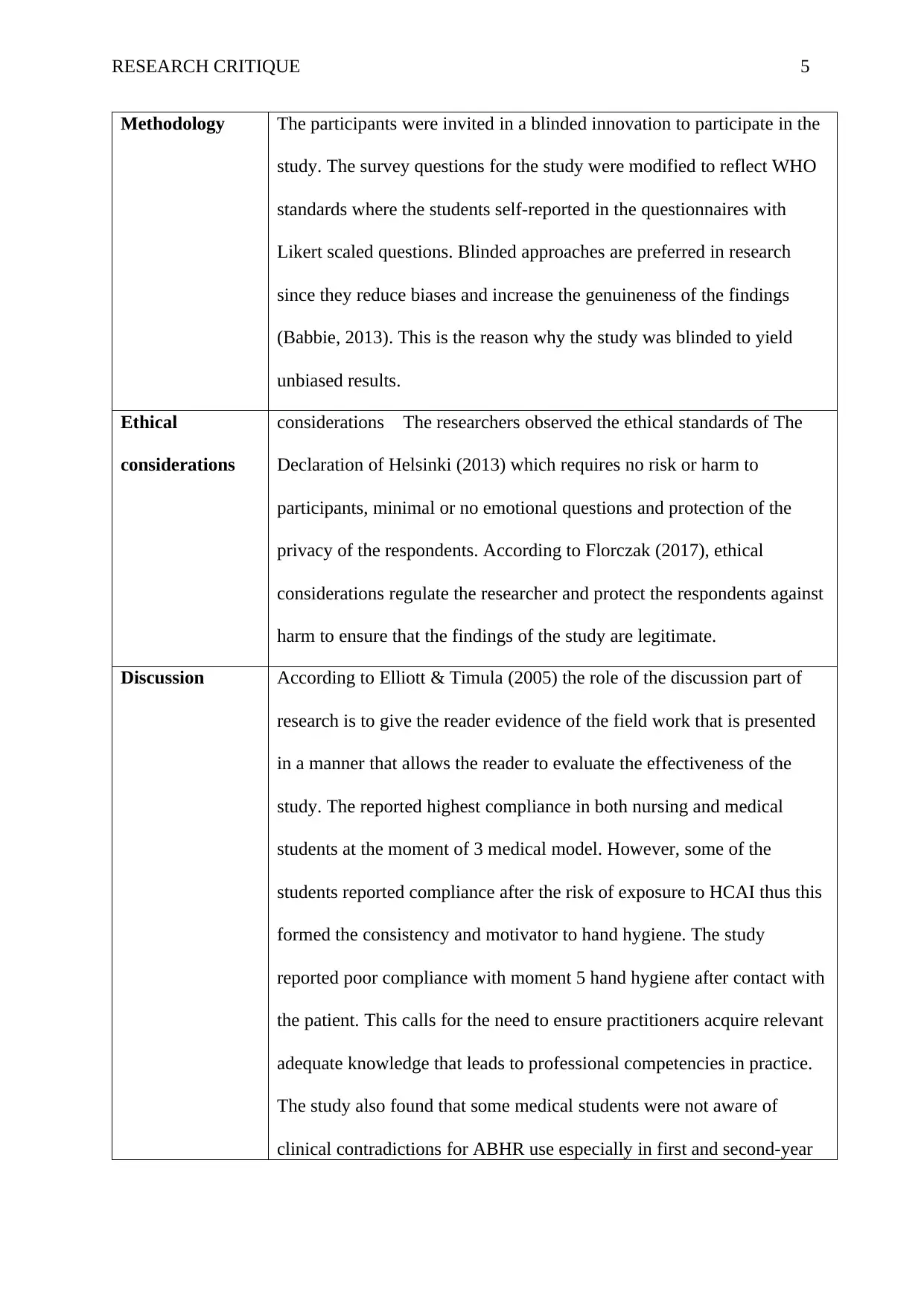
RESEARCH CRITIQUE 5
Methodology The participants were invited in a blinded innovation to participate in the
study. The survey questions for the study were modified to reflect WHO
standards where the students self-reported in the questionnaires with
Likert scaled questions. Blinded approaches are preferred in research
since they reduce biases and increase the genuineness of the findings
(Babbie, 2013). This is the reason why the study was blinded to yield
unbiased results.
Ethical
considerations
considerations The researchers observed the ethical standards of The
Declaration of Helsinki (2013) which requires no risk or harm to
participants, minimal or no emotional questions and protection of the
privacy of the respondents. According to Florczak (2017), ethical
considerations regulate the researcher and protect the respondents against
harm to ensure that the findings of the study are legitimate.
Discussion According to Elliott & Timula (2005) the role of the discussion part of
research is to give the reader evidence of the field work that is presented
in a manner that allows the reader to evaluate the effectiveness of the
study. The reported highest compliance in both nursing and medical
students at the moment of 3 medical model. However, some of the
students reported compliance after the risk of exposure to HCAI thus this
formed the consistency and motivator to hand hygiene. The study
reported poor compliance with moment 5 hand hygiene after contact with
the patient. This calls for the need to ensure practitioners acquire relevant
adequate knowledge that leads to professional competencies in practice.
The study also found that some medical students were not aware of
clinical contradictions for ABHR use especially in first and second-year
Methodology The participants were invited in a blinded innovation to participate in the
study. The survey questions for the study were modified to reflect WHO
standards where the students self-reported in the questionnaires with
Likert scaled questions. Blinded approaches are preferred in research
since they reduce biases and increase the genuineness of the findings
(Babbie, 2013). This is the reason why the study was blinded to yield
unbiased results.
Ethical
considerations
considerations The researchers observed the ethical standards of The
Declaration of Helsinki (2013) which requires no risk or harm to
participants, minimal or no emotional questions and protection of the
privacy of the respondents. According to Florczak (2017), ethical
considerations regulate the researcher and protect the respondents against
harm to ensure that the findings of the study are legitimate.
Discussion According to Elliott & Timula (2005) the role of the discussion part of
research is to give the reader evidence of the field work that is presented
in a manner that allows the reader to evaluate the effectiveness of the
study. The reported highest compliance in both nursing and medical
students at the moment of 3 medical model. However, some of the
students reported compliance after the risk of exposure to HCAI thus this
formed the consistency and motivator to hand hygiene. The study
reported poor compliance with moment 5 hand hygiene after contact with
the patient. This calls for the need to ensure practitioners acquire relevant
adequate knowledge that leads to professional competencies in practice.
The study also found that some medical students were not aware of
clinical contradictions for ABHR use especially in first and second-year
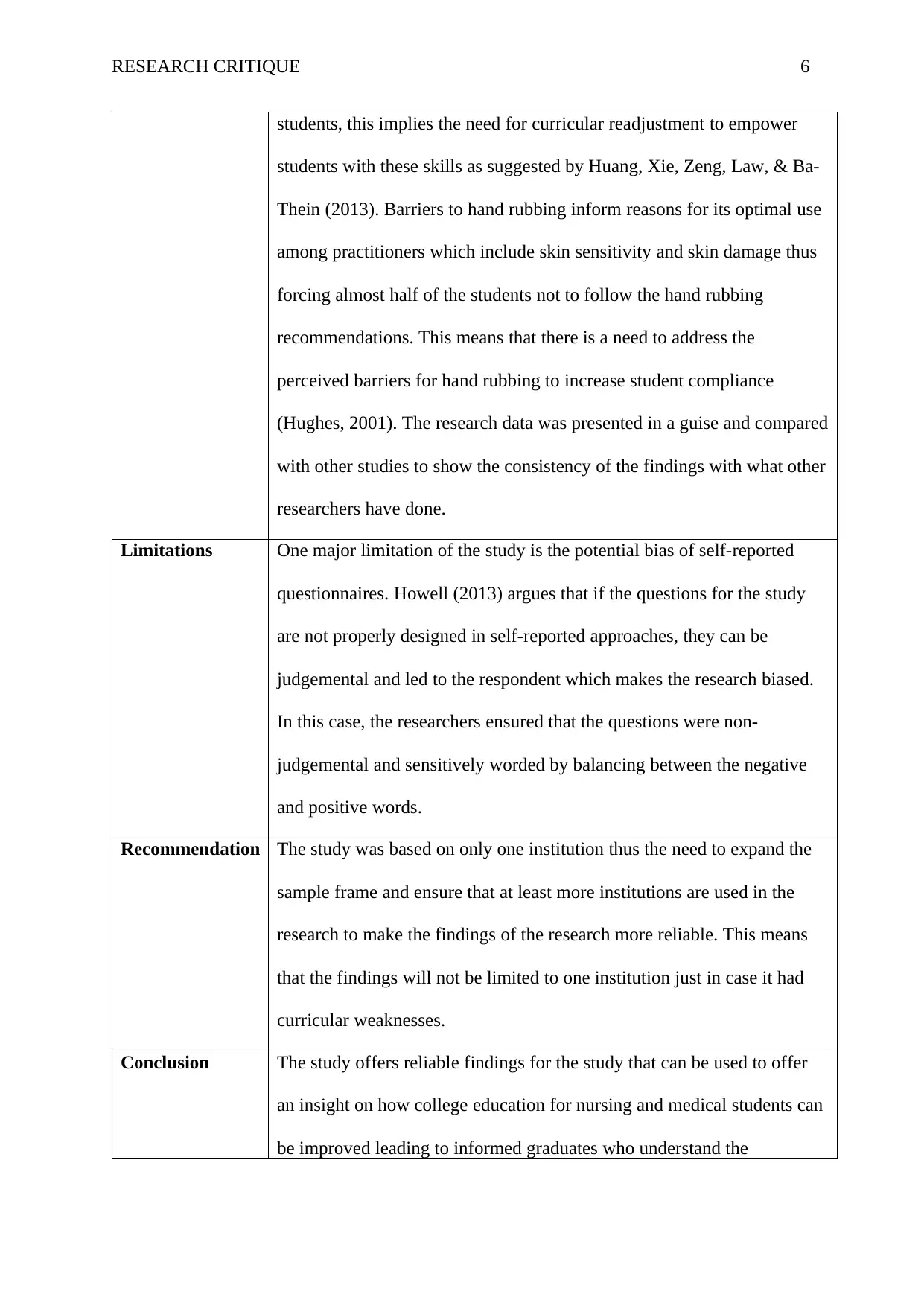
RESEARCH CRITIQUE 6
students, this implies the need for curricular readjustment to empower
students with these skills as suggested by Huang, Xie, Zeng, Law, & Ba-
Thein (2013). Barriers to hand rubbing inform reasons for its optimal use
among practitioners which include skin sensitivity and skin damage thus
forcing almost half of the students not to follow the hand rubbing
recommendations. This means that there is a need to address the
perceived barriers for hand rubbing to increase student compliance
(Hughes, 2001). The research data was presented in a guise and compared
with other studies to show the consistency of the findings with what other
researchers have done.
Limitations One major limitation of the study is the potential bias of self-reported
questionnaires. Howell (2013) argues that if the questions for the study
are not properly designed in self-reported approaches, they can be
judgemental and led to the respondent which makes the research biased.
In this case, the researchers ensured that the questions were non-
judgemental and sensitively worded by balancing between the negative
and positive words.
Recommendation The study was based on only one institution thus the need to expand the
sample frame and ensure that at least more institutions are used in the
research to make the findings of the research more reliable. This means
that the findings will not be limited to one institution just in case it had
curricular weaknesses.
Conclusion The study offers reliable findings for the study that can be used to offer
an insight on how college education for nursing and medical students can
be improved leading to informed graduates who understand the
students, this implies the need for curricular readjustment to empower
students with these skills as suggested by Huang, Xie, Zeng, Law, & Ba-
Thein (2013). Barriers to hand rubbing inform reasons for its optimal use
among practitioners which include skin sensitivity and skin damage thus
forcing almost half of the students not to follow the hand rubbing
recommendations. This means that there is a need to address the
perceived barriers for hand rubbing to increase student compliance
(Hughes, 2001). The research data was presented in a guise and compared
with other studies to show the consistency of the findings with what other
researchers have done.
Limitations One major limitation of the study is the potential bias of self-reported
questionnaires. Howell (2013) argues that if the questions for the study
are not properly designed in self-reported approaches, they can be
judgemental and led to the respondent which makes the research biased.
In this case, the researchers ensured that the questions were non-
judgemental and sensitively worded by balancing between the negative
and positive words.
Recommendation The study was based on only one institution thus the need to expand the
sample frame and ensure that at least more institutions are used in the
research to make the findings of the research more reliable. This means
that the findings will not be limited to one institution just in case it had
curricular weaknesses.
Conclusion The study offers reliable findings for the study that can be used to offer
an insight on how college education for nursing and medical students can
be improved leading to informed graduates who understand the
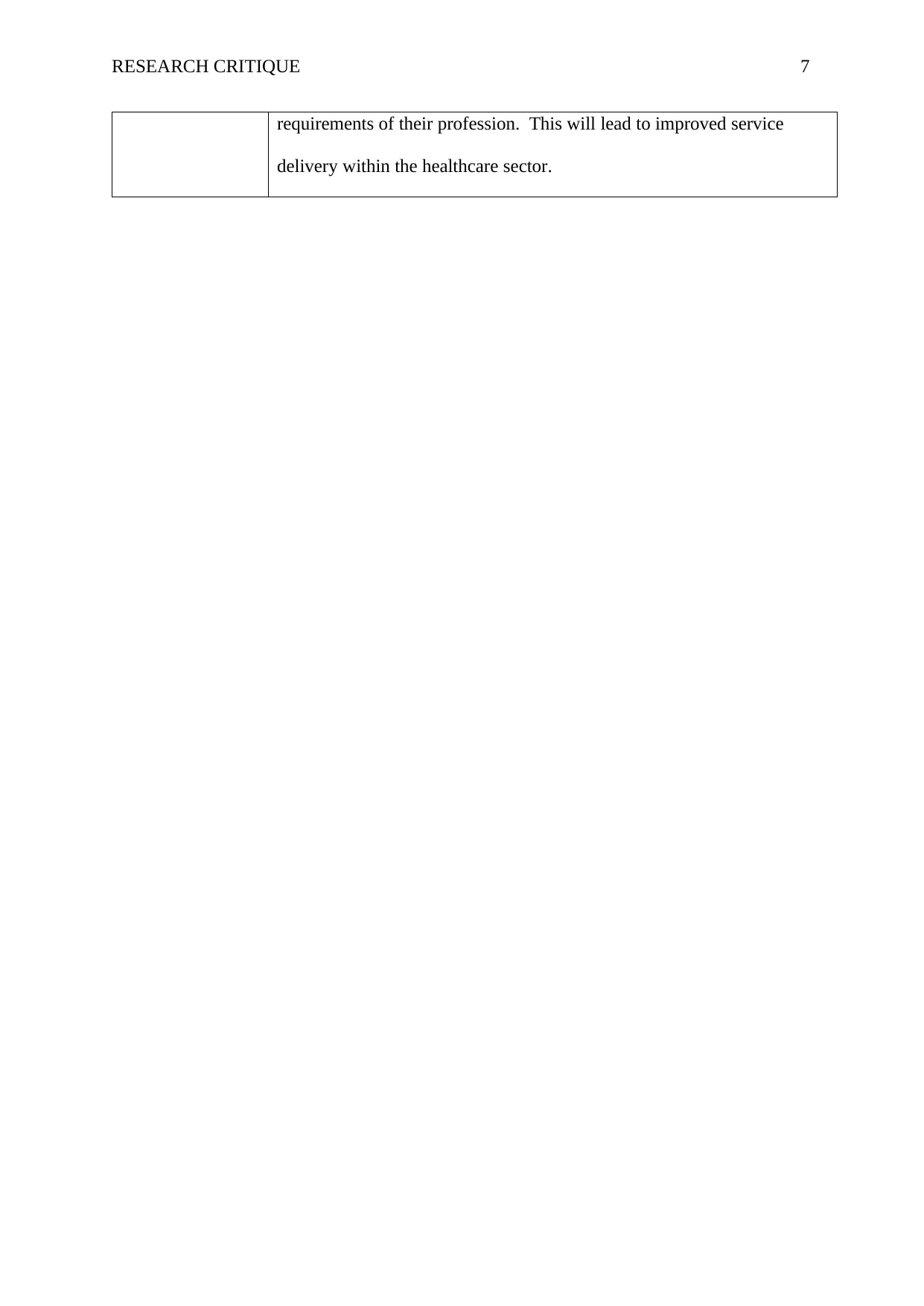
RESEARCH CRITIQUE 7
requirements of their profession. This will lead to improved service
delivery within the healthcare sector.
requirements of their profession. This will lead to improved service
delivery within the healthcare sector.
Paraphrase This Document
Need a fresh take? Get an instant paraphrase of this document with our AI Paraphraser
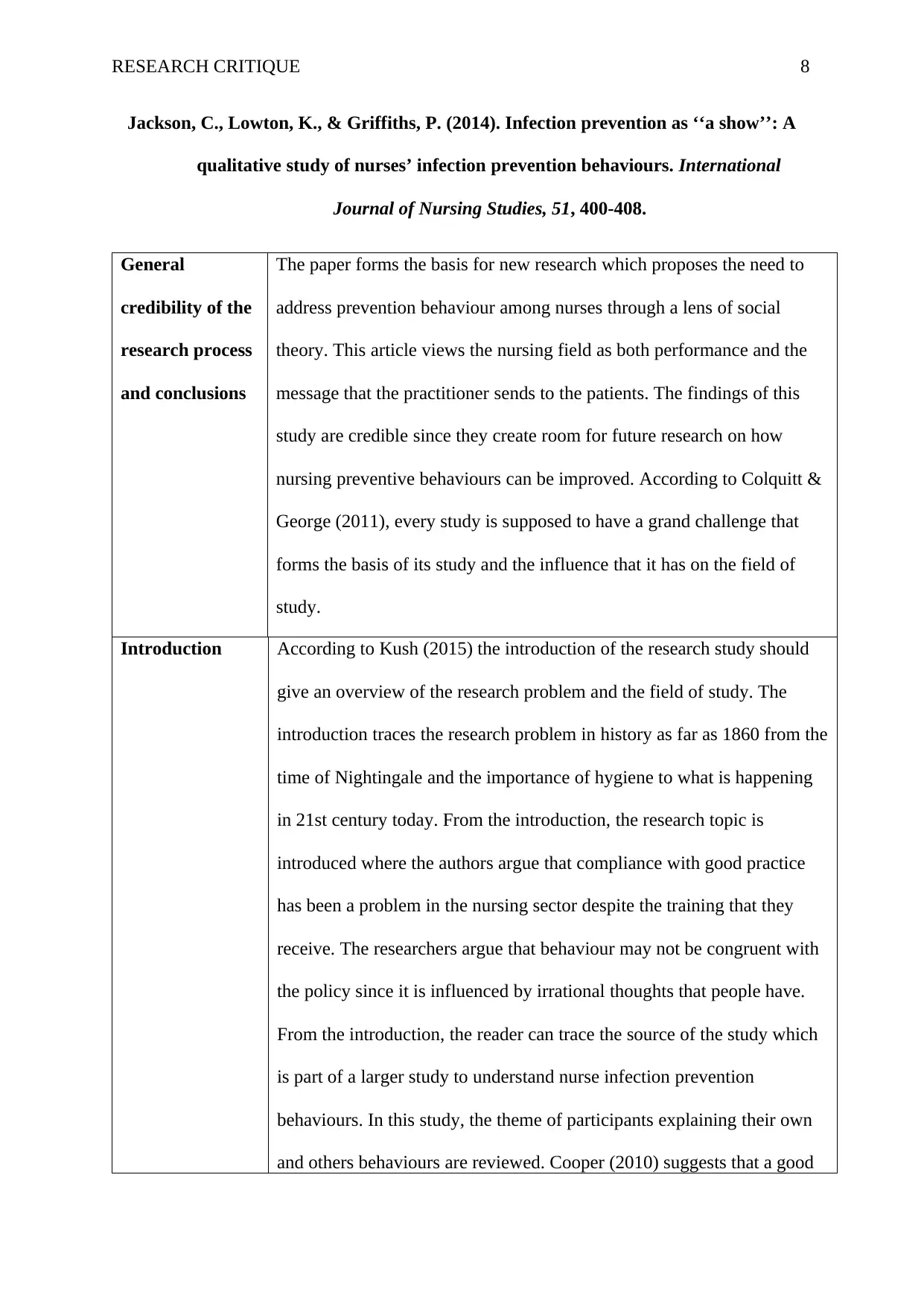
RESEARCH CRITIQUE 8
Jackson, C., Lowton, K., & Griffiths, P. (2014). Infection prevention as ‘‘a show’’: A
qualitative study of nurses’ infection prevention behaviours. International
Journal of Nursing Studies, 51, 400-408.
General
credibility of the
research process
and conclusions
The paper forms the basis for new research which proposes the need to
address prevention behaviour among nurses through a lens of social
theory. This article views the nursing field as both performance and the
message that the practitioner sends to the patients. The findings of this
study are credible since they create room for future research on how
nursing preventive behaviours can be improved. According to Colquitt &
George (2011), every study is supposed to have a grand challenge that
forms the basis of its study and the influence that it has on the field of
study.
Introduction According to Kush (2015) the introduction of the research study should
give an overview of the research problem and the field of study. The
introduction traces the research problem in history as far as 1860 from the
time of Nightingale and the importance of hygiene to what is happening
in 21st century today. From the introduction, the research topic is
introduced where the authors argue that compliance with good practice
has been a problem in the nursing sector despite the training that they
receive. The researchers argue that behaviour may not be congruent with
the policy since it is influenced by irrational thoughts that people have.
From the introduction, the reader can trace the source of the study which
is part of a larger study to understand nurse infection prevention
behaviours. In this study, the theme of participants explaining their own
and others behaviours are reviewed. Cooper (2010) suggests that a good
Jackson, C., Lowton, K., & Griffiths, P. (2014). Infection prevention as ‘‘a show’’: A
qualitative study of nurses’ infection prevention behaviours. International
Journal of Nursing Studies, 51, 400-408.
General
credibility of the
research process
and conclusions
The paper forms the basis for new research which proposes the need to
address prevention behaviour among nurses through a lens of social
theory. This article views the nursing field as both performance and the
message that the practitioner sends to the patients. The findings of this
study are credible since they create room for future research on how
nursing preventive behaviours can be improved. According to Colquitt &
George (2011), every study is supposed to have a grand challenge that
forms the basis of its study and the influence that it has on the field of
study.
Introduction According to Kush (2015) the introduction of the research study should
give an overview of the research problem and the field of study. The
introduction traces the research problem in history as far as 1860 from the
time of Nightingale and the importance of hygiene to what is happening
in 21st century today. From the introduction, the research topic is
introduced where the authors argue that compliance with good practice
has been a problem in the nursing sector despite the training that they
receive. The researchers argue that behaviour may not be congruent with
the policy since it is influenced by irrational thoughts that people have.
From the introduction, the reader can trace the source of the study which
is part of a larger study to understand nurse infection prevention
behaviours. In this study, the theme of participants explaining their own
and others behaviours are reviewed. Cooper (2010) suggests that a good
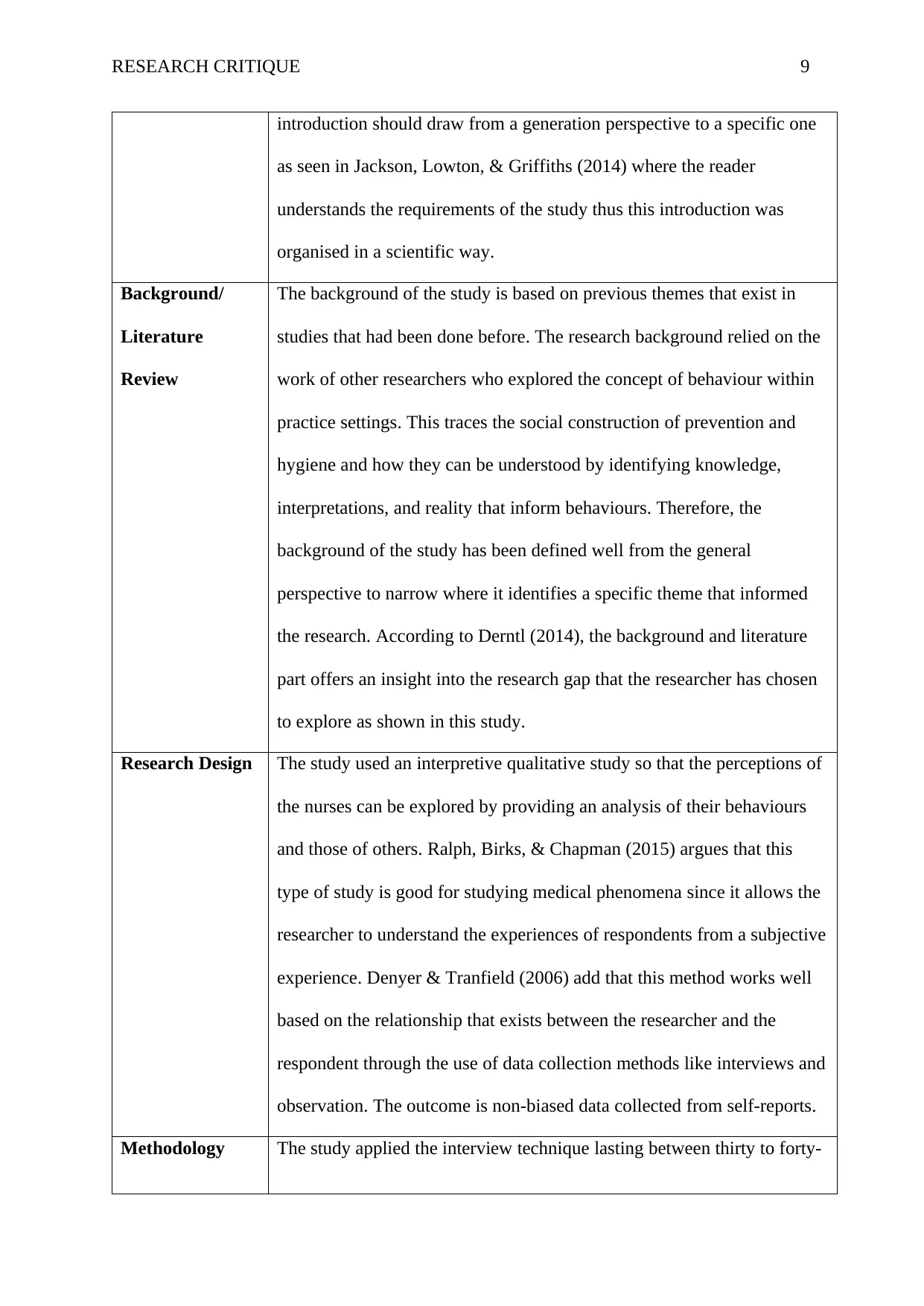
RESEARCH CRITIQUE 9
introduction should draw from a generation perspective to a specific one
as seen in Jackson, Lowton, & Griffiths (2014) where the reader
understands the requirements of the study thus this introduction was
organised in a scientific way.
Background/
Literature
Review
The background of the study is based on previous themes that exist in
studies that had been done before. The research background relied on the
work of other researchers who explored the concept of behaviour within
practice settings. This traces the social construction of prevention and
hygiene and how they can be understood by identifying knowledge,
interpretations, and reality that inform behaviours. Therefore, the
background of the study has been defined well from the general
perspective to narrow where it identifies a specific theme that informed
the research. According to Derntl (2014), the background and literature
part offers an insight into the research gap that the researcher has chosen
to explore as shown in this study.
Research Design The study used an interpretive qualitative study so that the perceptions of
the nurses can be explored by providing an analysis of their behaviours
and those of others. Ralph, Birks, & Chapman (2015) argues that this
type of study is good for studying medical phenomena since it allows the
researcher to understand the experiences of respondents from a subjective
experience. Denyer & Tranfield (2006) add that this method works well
based on the relationship that exists between the researcher and the
respondent through the use of data collection methods like interviews and
observation. The outcome is non-biased data collected from self-reports.
Methodology The study applied the interview technique lasting between thirty to forty-
introduction should draw from a generation perspective to a specific one
as seen in Jackson, Lowton, & Griffiths (2014) where the reader
understands the requirements of the study thus this introduction was
organised in a scientific way.
Background/
Literature
Review
The background of the study is based on previous themes that exist in
studies that had been done before. The research background relied on the
work of other researchers who explored the concept of behaviour within
practice settings. This traces the social construction of prevention and
hygiene and how they can be understood by identifying knowledge,
interpretations, and reality that inform behaviours. Therefore, the
background of the study has been defined well from the general
perspective to narrow where it identifies a specific theme that informed
the research. According to Derntl (2014), the background and literature
part offers an insight into the research gap that the researcher has chosen
to explore as shown in this study.
Research Design The study used an interpretive qualitative study so that the perceptions of
the nurses can be explored by providing an analysis of their behaviours
and those of others. Ralph, Birks, & Chapman (2015) argues that this
type of study is good for studying medical phenomena since it allows the
researcher to understand the experiences of respondents from a subjective
experience. Denyer & Tranfield (2006) add that this method works well
based on the relationship that exists between the researcher and the
respondent through the use of data collection methods like interviews and
observation. The outcome is non-biased data collected from self-reports.
Methodology The study applied the interview technique lasting between thirty to forty-
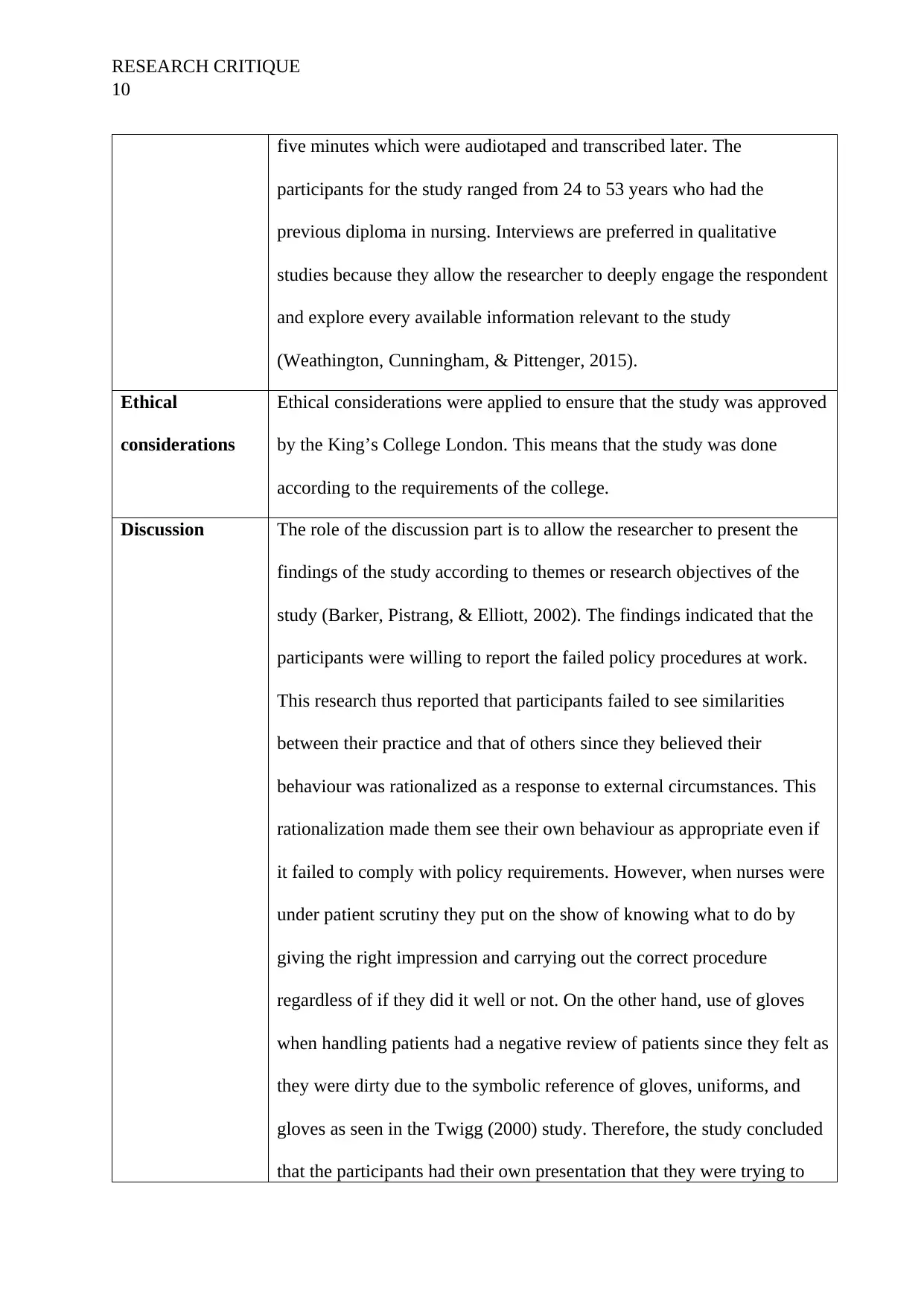
RESEARCH CRITIQUE
10
five minutes which were audiotaped and transcribed later. The
participants for the study ranged from 24 to 53 years who had the
previous diploma in nursing. Interviews are preferred in qualitative
studies because they allow the researcher to deeply engage the respondent
and explore every available information relevant to the study
(Weathington, Cunningham, & Pittenger, 2015).
Ethical
considerations
Ethical considerations were applied to ensure that the study was approved
by the King’s College London. This means that the study was done
according to the requirements of the college.
Discussion The role of the discussion part is to allow the researcher to present the
findings of the study according to themes or research objectives of the
study (Barker, Pistrang, & Elliott, 2002). The findings indicated that the
participants were willing to report the failed policy procedures at work.
This research thus reported that participants failed to see similarities
between their practice and that of others since they believed their
behaviour was rationalized as a response to external circumstances. This
rationalization made them see their own behaviour as appropriate even if
it failed to comply with policy requirements. However, when nurses were
under patient scrutiny they put on the show of knowing what to do by
giving the right impression and carrying out the correct procedure
regardless of if they did it well or not. On the other hand, use of gloves
when handling patients had a negative review of patients since they felt as
they were dirty due to the symbolic reference of gloves, uniforms, and
gloves as seen in the Twigg (2000) study. Therefore, the study concluded
that the participants had their own presentation that they were trying to
10
five minutes which were audiotaped and transcribed later. The
participants for the study ranged from 24 to 53 years who had the
previous diploma in nursing. Interviews are preferred in qualitative
studies because they allow the researcher to deeply engage the respondent
and explore every available information relevant to the study
(Weathington, Cunningham, & Pittenger, 2015).
Ethical
considerations
Ethical considerations were applied to ensure that the study was approved
by the King’s College London. This means that the study was done
according to the requirements of the college.
Discussion The role of the discussion part is to allow the researcher to present the
findings of the study according to themes or research objectives of the
study (Barker, Pistrang, & Elliott, 2002). The findings indicated that the
participants were willing to report the failed policy procedures at work.
This research thus reported that participants failed to see similarities
between their practice and that of others since they believed their
behaviour was rationalized as a response to external circumstances. This
rationalization made them see their own behaviour as appropriate even if
it failed to comply with policy requirements. However, when nurses were
under patient scrutiny they put on the show of knowing what to do by
giving the right impression and carrying out the correct procedure
regardless of if they did it well or not. On the other hand, use of gloves
when handling patients had a negative review of patients since they felt as
they were dirty due to the symbolic reference of gloves, uniforms, and
gloves as seen in the Twigg (2000) study. Therefore, the study concluded
that the participants had their own presentation that they were trying to
Secure Best Marks with AI Grader
Need help grading? Try our AI Grader for instant feedback on your assignments.
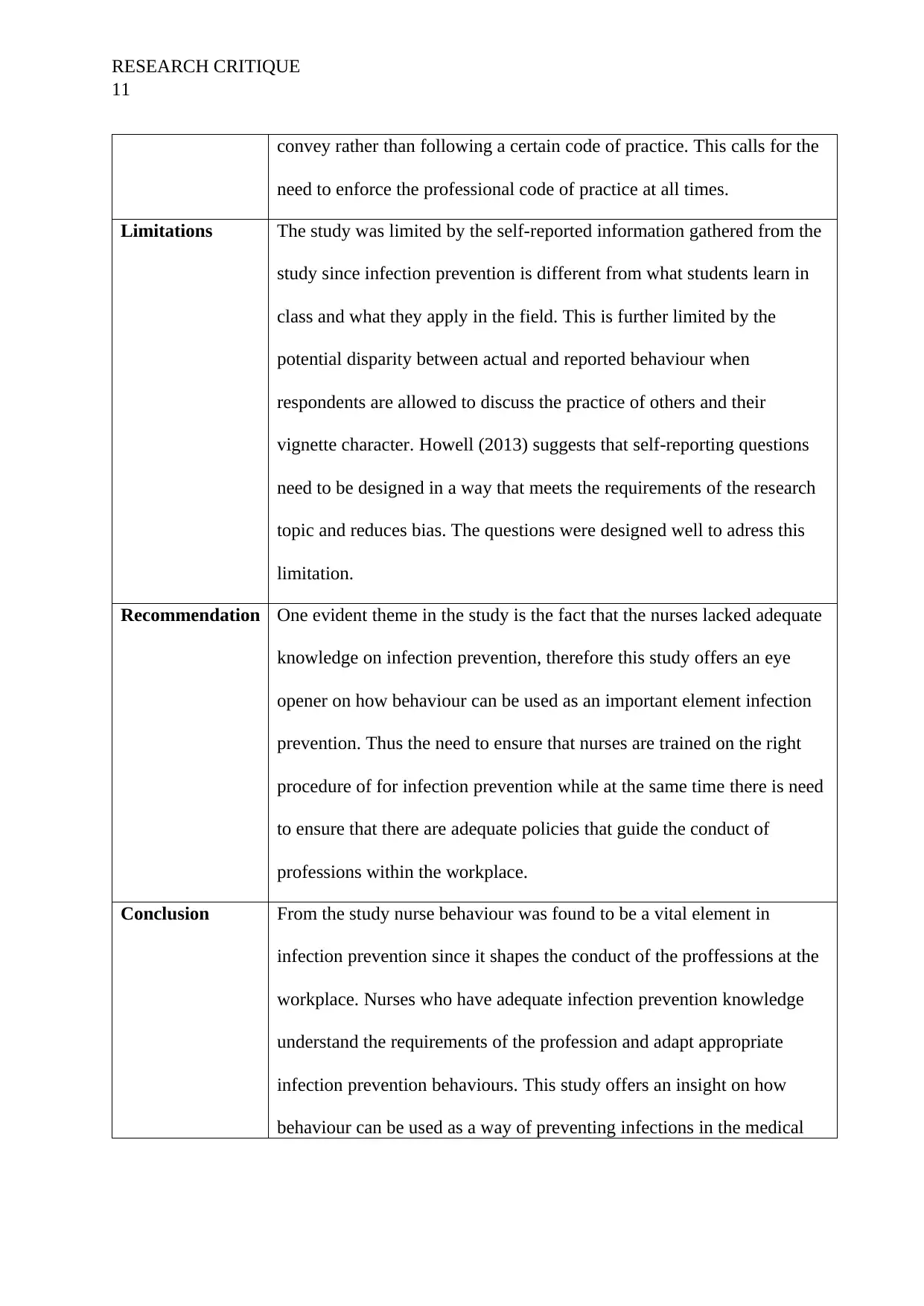
RESEARCH CRITIQUE
11
convey rather than following a certain code of practice. This calls for the
need to enforce the professional code of practice at all times.
Limitations The study was limited by the self-reported information gathered from the
study since infection prevention is different from what students learn in
class and what they apply in the field. This is further limited by the
potential disparity between actual and reported behaviour when
respondents are allowed to discuss the practice of others and their
vignette character. Howell (2013) suggests that self-reporting questions
need to be designed in a way that meets the requirements of the research
topic and reduces bias. The questions were designed well to adress this
limitation.
Recommendation One evident theme in the study is the fact that the nurses lacked adequate
knowledge on infection prevention, therefore this study offers an eye
opener on how behaviour can be used as an important element infection
prevention. Thus the need to ensure that nurses are trained on the right
procedure of for infection prevention while at the same time there is need
to ensure that there are adequate policies that guide the conduct of
professions within the workplace.
Conclusion From the study nurse behaviour was found to be a vital element in
infection prevention since it shapes the conduct of the proffessions at the
workplace. Nurses who have adequate infection prevention knowledge
understand the requirements of the profession and adapt appropriate
infection prevention behaviours. This study offers an insight on how
behaviour can be used as a way of preventing infections in the medical
11
convey rather than following a certain code of practice. This calls for the
need to enforce the professional code of practice at all times.
Limitations The study was limited by the self-reported information gathered from the
study since infection prevention is different from what students learn in
class and what they apply in the field. This is further limited by the
potential disparity between actual and reported behaviour when
respondents are allowed to discuss the practice of others and their
vignette character. Howell (2013) suggests that self-reporting questions
need to be designed in a way that meets the requirements of the research
topic and reduces bias. The questions were designed well to adress this
limitation.
Recommendation One evident theme in the study is the fact that the nurses lacked adequate
knowledge on infection prevention, therefore this study offers an eye
opener on how behaviour can be used as an important element infection
prevention. Thus the need to ensure that nurses are trained on the right
procedure of for infection prevention while at the same time there is need
to ensure that there are adequate policies that guide the conduct of
professions within the workplace.
Conclusion From the study nurse behaviour was found to be a vital element in
infection prevention since it shapes the conduct of the proffessions at the
workplace. Nurses who have adequate infection prevention knowledge
understand the requirements of the profession and adapt appropriate
infection prevention behaviours. This study offers an insight on how
behaviour can be used as a way of preventing infections in the medical
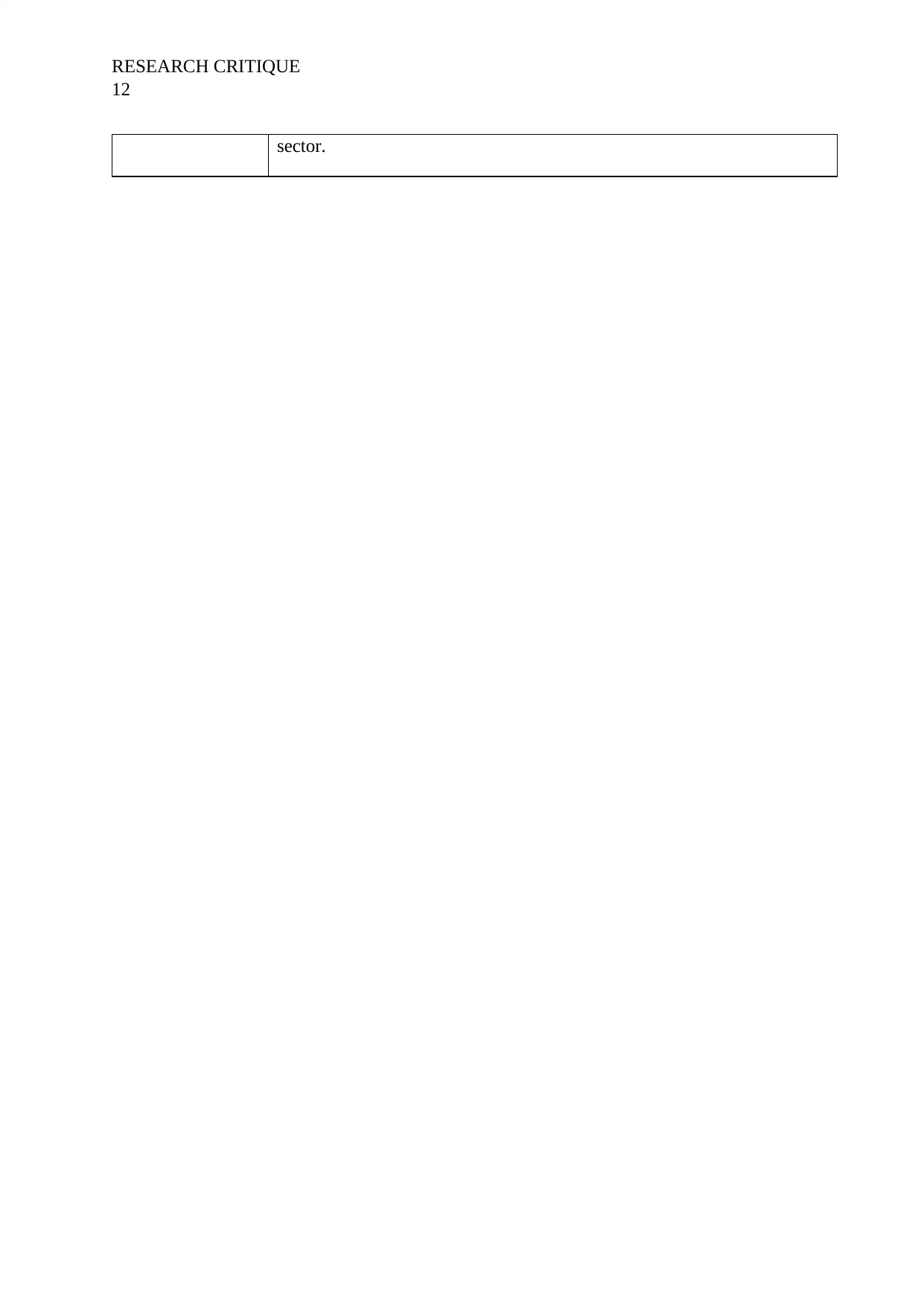
RESEARCH CRITIQUE
12
sector.
12
sector.
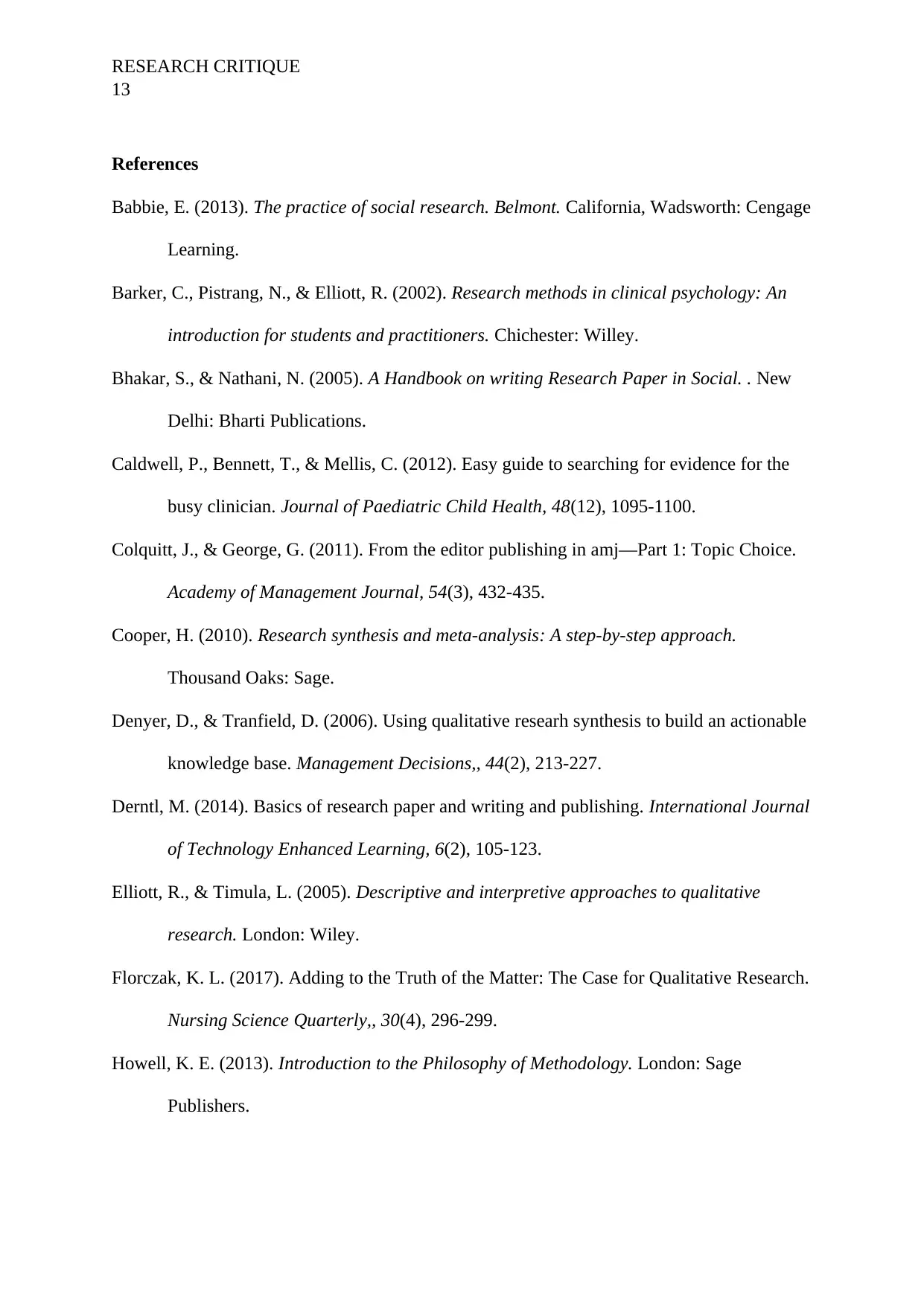
RESEARCH CRITIQUE
13
References
Babbie, E. (2013). The practice of social research. Belmont. California, Wadsworth: Cengage
Learning.
Barker, C., Pistrang, N., & Elliott, R. (2002). Research methods in clinical psychology: An
introduction for students and practitioners. Chichester: Willey.
Bhakar, S., & Nathani, N. (2005). A Handbook on writing Research Paper in Social. . New
Delhi: Bharti Publications.
Caldwell, P., Bennett, T., & Mellis, C. (2012). Easy guide to searching for evidence for the
busy clinician. Journal of Paediatric Child Health, 48(12), 1095-1100.
Colquitt, J., & George, G. (2011). From the editor publishing in amj—Part 1: Topic Choice.
Academy of Management Journal, 54(3), 432-435.
Cooper, H. (2010). Research synthesis and meta-analysis: A step-by-step approach.
Thousand Oaks: Sage.
Denyer, D., & Tranfield, D. (2006). Using qualitative researh synthesis to build an actionable
knowledge base. Management Decisions,, 44(2), 213-227.
Derntl, M. (2014). Basics of research paper and writing and publishing. International Journal
of Technology Enhanced Learning, 6(2), 105-123.
Elliott, R., & Timula, L. (2005). Descriptive and interpretive approaches to qualitative
research. London: Wiley.
Florczak, K. L. (2017). Adding to the Truth of the Matter: The Case for Qualitative Research.
Nursing Science Quarterly,, 30(4), 296-299.
Howell, K. E. (2013). Introduction to the Philosophy of Methodology. London: Sage
Publishers.
13
References
Babbie, E. (2013). The practice of social research. Belmont. California, Wadsworth: Cengage
Learning.
Barker, C., Pistrang, N., & Elliott, R. (2002). Research methods in clinical psychology: An
introduction for students and practitioners. Chichester: Willey.
Bhakar, S., & Nathani, N. (2005). A Handbook on writing Research Paper in Social. . New
Delhi: Bharti Publications.
Caldwell, P., Bennett, T., & Mellis, C. (2012). Easy guide to searching for evidence for the
busy clinician. Journal of Paediatric Child Health, 48(12), 1095-1100.
Colquitt, J., & George, G. (2011). From the editor publishing in amj—Part 1: Topic Choice.
Academy of Management Journal, 54(3), 432-435.
Cooper, H. (2010). Research synthesis and meta-analysis: A step-by-step approach.
Thousand Oaks: Sage.
Denyer, D., & Tranfield, D. (2006). Using qualitative researh synthesis to build an actionable
knowledge base. Management Decisions,, 44(2), 213-227.
Derntl, M. (2014). Basics of research paper and writing and publishing. International Journal
of Technology Enhanced Learning, 6(2), 105-123.
Elliott, R., & Timula, L. (2005). Descriptive and interpretive approaches to qualitative
research. London: Wiley.
Florczak, K. L. (2017). Adding to the Truth of the Matter: The Case for Qualitative Research.
Nursing Science Quarterly,, 30(4), 296-299.
Howell, K. E. (2013). Introduction to the Philosophy of Methodology. London: Sage
Publishers.
Paraphrase This Document
Need a fresh take? Get an instant paraphrase of this document with our AI Paraphraser
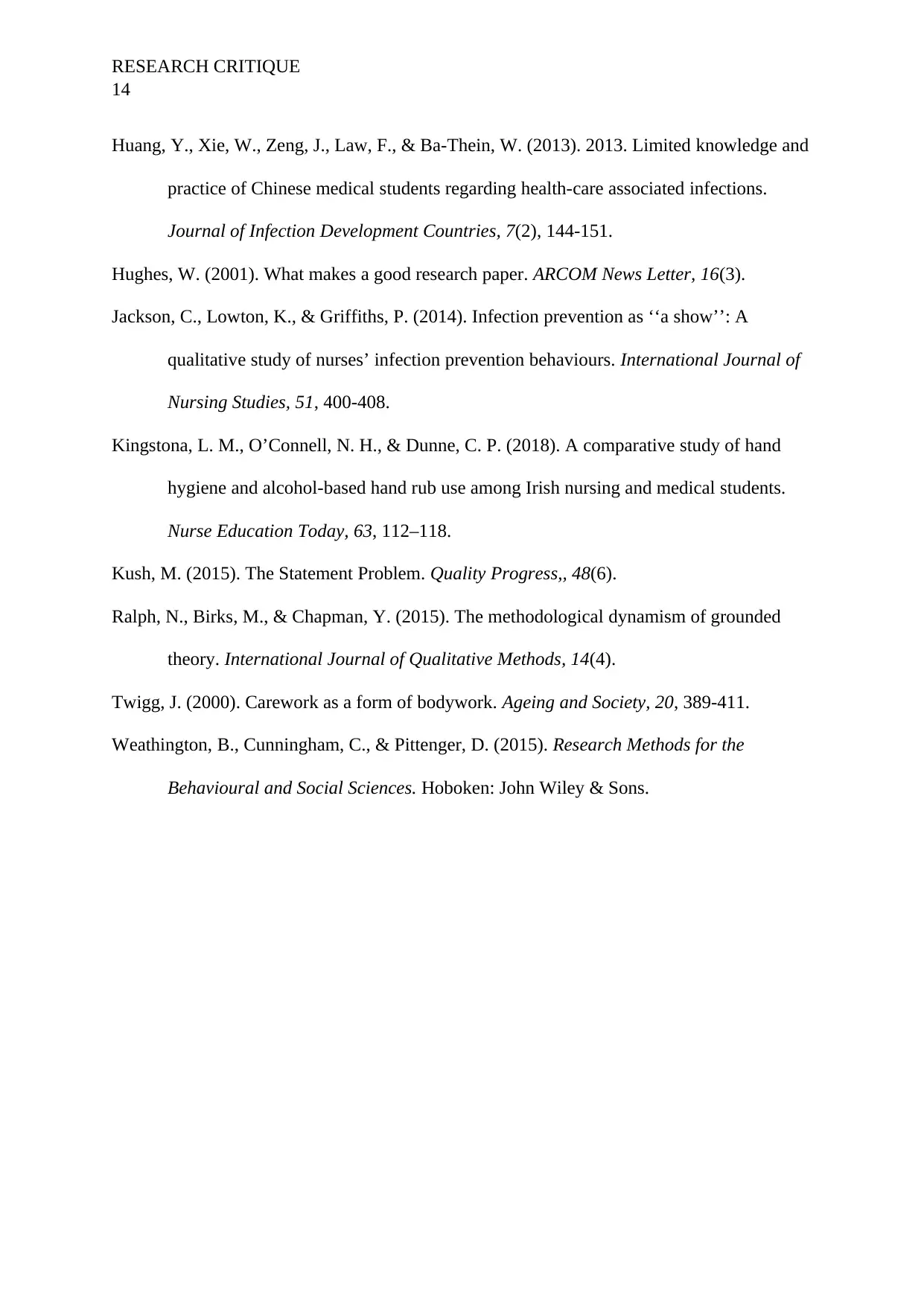
RESEARCH CRITIQUE
14
Huang, Y., Xie, W., Zeng, J., Law, F., & Ba-Thein, W. (2013). 2013. Limited knowledge and
practice of Chinese medical students regarding health-care associated infections.
Journal of Infection Development Countries, 7(2), 144-151.
Hughes, W. (2001). What makes a good research paper. ARCOM News Letter, 16(3).
Jackson, C., Lowton, K., & Griffiths, P. (2014). Infection prevention as ‘‘a show’’: A
qualitative study of nurses’ infection prevention behaviours. International Journal of
Nursing Studies, 51, 400-408.
Kingstona, L. M., O’Connell, N. H., & Dunne, C. P. (2018). A comparative study of hand
hygiene and alcohol-based hand rub use among Irish nursing and medical students.
Nurse Education Today, 63, 112–118.
Kush, M. (2015). The Statement Problem. Quality Progress,, 48(6).
Ralph, N., Birks, M., & Chapman, Y. (2015). The methodological dynamism of grounded
theory. International Journal of Qualitative Methods, 14(4).
Twigg, J. (2000). Carework as a form of bodywork. Ageing and Society, 20, 389-411.
Weathington, B., Cunningham, C., & Pittenger, D. (2015). Research Methods for the
Behavioural and Social Sciences. Hoboken: John Wiley & Sons.
14
Huang, Y., Xie, W., Zeng, J., Law, F., & Ba-Thein, W. (2013). 2013. Limited knowledge and
practice of Chinese medical students regarding health-care associated infections.
Journal of Infection Development Countries, 7(2), 144-151.
Hughes, W. (2001). What makes a good research paper. ARCOM News Letter, 16(3).
Jackson, C., Lowton, K., & Griffiths, P. (2014). Infection prevention as ‘‘a show’’: A
qualitative study of nurses’ infection prevention behaviours. International Journal of
Nursing Studies, 51, 400-408.
Kingstona, L. M., O’Connell, N. H., & Dunne, C. P. (2018). A comparative study of hand
hygiene and alcohol-based hand rub use among Irish nursing and medical students.
Nurse Education Today, 63, 112–118.
Kush, M. (2015). The Statement Problem. Quality Progress,, 48(6).
Ralph, N., Birks, M., & Chapman, Y. (2015). The methodological dynamism of grounded
theory. International Journal of Qualitative Methods, 14(4).
Twigg, J. (2000). Carework as a form of bodywork. Ageing and Society, 20, 389-411.
Weathington, B., Cunningham, C., & Pittenger, D. (2015). Research Methods for the
Behavioural and Social Sciences. Hoboken: John Wiley & Sons.
1 out of 14
Related Documents
Your All-in-One AI-Powered Toolkit for Academic Success.
+13062052269
info@desklib.com
Available 24*7 on WhatsApp / Email
![[object Object]](/_next/static/media/star-bottom.7253800d.svg)
Unlock your academic potential
© 2024 | Zucol Services PVT LTD | All rights reserved.





